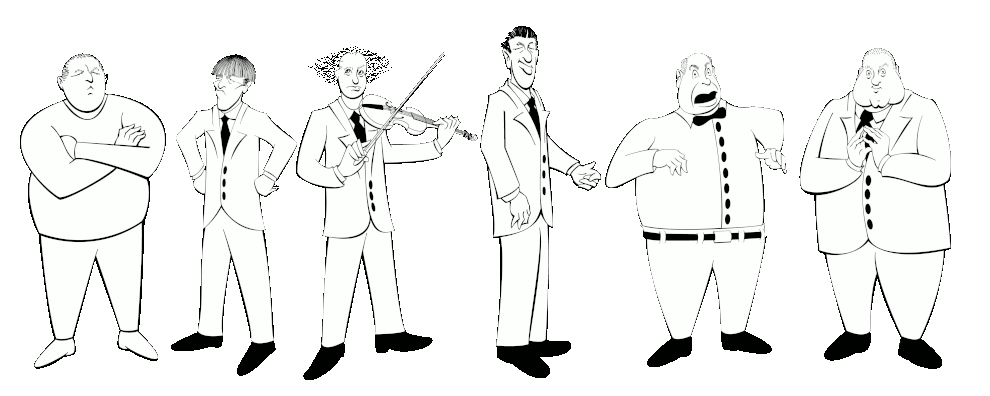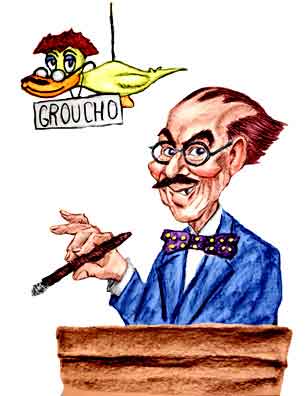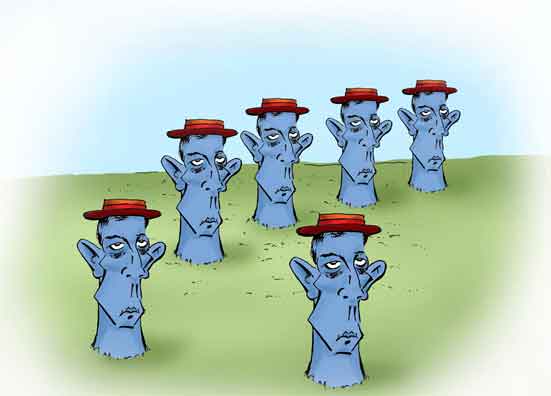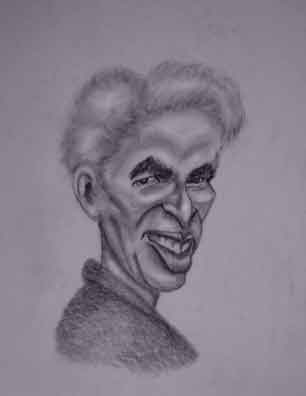The Three Stooges

(Click on the image to zoom in.)
You would think by now that someone would have written a Ph. D. thesis about the Three Stooges. But a diligent search has found nothing of that sort. True, there's a doctoral thesis about Charlie Chaplin, but there hasn't been a commensurate scholarly study about the contributions to world culture by Howard, Fine, and Howard.
And yet it was Moe who performed the first satirical imitation ridiculing the grandson of Maria Schicklgruber. This was in You Natzy Spy! of 1940. At that time many Americans still wanted to keep out of a conflict that they saw as a purely European problem. Along with Charlie Chaplin's The Great Dictator released nine months later, Moe's depiction has been credited with moving public sentiment away from the isolationism that had been prevalent in the United States.
The Great Dictator is listed on the National Film Registry of the Library of Congress. And although the Stooges 1934 movie Punch Drunks is also cited as being "culturally, historically, or aesthetically significant", no other Stooges films have been included in that prestigious collection.
The omission of You Natzy Spy! is decidedly strange given the films that have made the list. These include The Lion King, The Goonies, A Nightmare on Elm Street, The Blues Brothers, The Muppet Movie, Animal House, Superman, Saturday Night Fever, Young Frankenstein, Willy Wonka and the Chocolate Factory, Easy Rider, The Man Who Shot Liberty Valance, Some Like It Hot, The Seventh Voyage of Sinbad, Will Success Spoil Rock Hunter?, and - get this - Jailhouse Rock.
So why if not an actual snubbing is there the exclusion of the Stooges?
Whenever you read about innovators of modern comedy, you'll find Charlie Chaplin (of course), Buster Keaton, Harold Lloyd, and Fatty Arbuckle. Those of later eras are comedians like Groucho Marx, Laurel and Hardy, and Henny Youngman.
Great Comedians

Groucho ...

... and Henny ...

... and Buster ...

... and Stan and Ollie ...

... and (of course) Charlie.
But you'll never read that the Stooges were true innovators. In a recent list of the "100 Greatest Comedians" there's the likes of Jason Mewes, Steve Carell, Sacha Baron Cohen, Harpo Marx, John Cleese, Nathan Lane, Jeff Anderson, Seth Rogen, Lloyd Bridges, Whoopi Goldberg, Ed O'Neill, Jack Lemmon, Kevin Kline, Groucho Marx, Rowan Atkinson, Leslie Nielsen, Eddie Murphy, Groucho Marx, Walter Matthau, Chevy Chase, Dudley Moore, Gene Wilder, Steve Martin, Mike Myers, Ben Stiller, Billy Crystal, Richard Pryor, Louis de Funès, Joe Pesci, Marty Feldman, Simon Pegg, Jon Lovitz, Mel Brooks, Zach Braff, Harvey Korman, Harold Lloyd, Randy Quaid, Kenneth Williams, Jim Carrey, Jack Black, Jacques Tati, Ricky Gervais, Will Smith, Alan Alda, John Belushi, Dan Aykroyd, Adam Sandler, Benny Hill, John Candy, Bill Murray, Woody Allen, Steve Guttenberg, Eric Idle, Rick Moranis, Peter Sellers, David Schwimmer, Michael Palin, Tom Hanks, Danny DeVito, Roberto Benigni, Charles Chaplin, Pierre Richard, Zero Mostel, Larry David, Buster Keaton, Stan Laurel, and Will Ferrell. But none of the Stooges - not even Jerome "Curly" Howard - is in the top celebration.
Perhaps the omission is - strangely - because the Stooges were unique. No one afterwards has ever done anything like the Stooges. If anyone had tried they would have been dismissed as mere "Stooge imitators". An attempt at making a new Stooges movie in a post Millennium setting - and despite quite credible performances - received decidedly mixed reviews. So if they don't have imitators, then it's easy to claim they didn't "influence" those who came later.
The Stooges short films were produced by Columbia Pictures for the theaters, but they were rediscovered by a new generation when they were released on television in 1959. The length of the "shorts" - 15 to 20 minutes - fit perfectly into a one hour television show with time included for commercials directed at the kids.
The television shows revitalized the Stooges popularity, but perhaps the effect was not all positive. Now the Stooges had to contend not only with the Taint of Television - even then called "the great wasteland" - but it seems that they were now mostly suited only for a (ptui) "children's show".
And we have to admit their brand of slapstick was rather rough. There were the face slap, the forehead smack, the head bonk, and (of course) the eye-poke, not to mention being hit with hammers, picks, and raked with saws. Of course, the kids understood that the slapstick employed special props and techniques, but some parents were concerned that the kids would imitate the behavior.
Although from some docudramatizations of the Stooges' lives, you may come away with the impression that the Stooges were relegated to almost menial jobs after Columbia decided to close down their short film department. That was certainly not true. Almost from the moment the productions ceased, they received requests for lucrative personal appearances. Moe was amazed that promoters would offer them $25,000 - that's late 1950's dollars - for an hour's appearance for something like a supermarket opening.
Columbia had been reluctant to depart from the short film venues, but now that the Stooges were no longer under contract they could make what they liked. Almost immediately they began starring in full length features: Have Rocket, Will Travel (1959), Snow White and the Three Stooges (1961), The Three Stooges Meet Hercules (1962), The Three Stooges in Orbit (1962), The Three Stooges Go Around the World in a Daze (1963). Their last film was The Outlaws IS Coming! (1965) whose co-star Adam West achieved iconic fame a year later as the star of television's campy Batman series.
Of course, the feature films - and guest appearances in movies like It's a Mad, Mad, Mad, Mad World and 4 for Texas - starred the Stooges last incarnation: Moe, Larry, and "Curly Joe" DeRita. Joe didn't quite have the energetic (not to mention maniacal) performances of the original Curly. Also the boys were not getting any younger and had to cut back on the more strenuous slapstick.
Shemp had become the third Stooge in 1946. Earlier that year Curly had been on the set filming Halfwits Holiday when he suffered a stroke. The last few minutes - a pie fight, of course - featured only Larry and Moe. Moe insisted the only replacement for the trio could be Shemp who had actually been one of the Stooges in the pre-Curly days when they performed on vaudeville and in the Ted Healey films.
Shemp was never as popular as Curly and it wasn't uncommon for the kids plopping themselves down for some after school relaxation with the Stooges only to groan in dismay when they saw the title card with Shemp, Moe, and Larry. Perhaps that does an injustice to Shemp's ability but Curly has been correctly labeled as the Superstooge. In his later years, Larry credited Curly with much of their success.
The often forgotten Stooge was Joe Besser who joined the group after Shemp died unexpectedly of a heart attack in 1955. Joe's character was not as popular as Curly or Shemp as he tended to be rather whiny and querulous. He was only in the final sixteen of the short films, the last of which was Sappy Bullfighters itself a remake of What's the Matador? of 1942.
After completing The Outlaws IS Coming the Stooges returned to television where they voiced characters for a cartoon show, characters based on - who else? - the Three Stooges. But in 1970 Larry suffered a debilitating stroke and plans were made to replace him with Emil Sitka who had been a supporting actor in over 30 of the Stooge films. But although there were publicity photos taken with Emil sporting the Larry-like frizz, no further films were made and the Stooges act effectively came to an end.
References and Further Reading
Moe Howard and the 3 Stooges: The Pictorial Biography of the Wildest Trio in the History of American Entertainment, Moe Howard, Citadel Press, 1977.
Curly: An Illustrated Biography of the Superstooge, Joan Howard Maurer, Citadel Press, 1988.
Larry: The Stooge in the Middle, Morris Feinberg, Last Gasp of San Francisco, 1984.
"The Chaplin Craze: Charlie Chaplin and the Emergence of Mass-Amusement Culture", Jack Rundell, Ph. D. Thesis, University of Youk, 2014.
"The Three Stooges vs. the Third Reich", Roy Schwartzman, Carolinas Communication Annual, 1998.
"Complete National Film Registry Listing", National Film Preservation Board, Library of Congress.